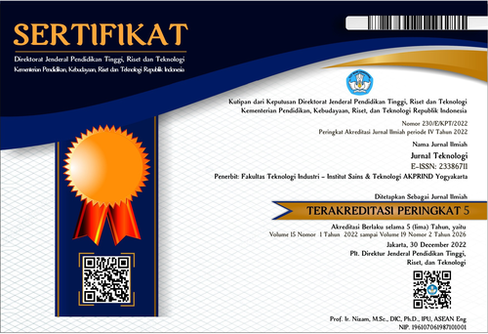Artificial Intelligence Tools in Higher Education Students Usage Analysis – Case Study: Sampoerna University
DOI:
https://doi.org/10.34151/jurtek.v16i2.4544Keywords:
artificial intelligence, higher education, tools, usage analysisAbstract
The potential application of AI in education has become an area captivating the younger generation. Among higher education students, AI tools support academic activities by providing students with personalized learning experiences that digitize each student's needs and abilities. This research aims to determine the adoption of AI tools in academic areas, specifically at Sampoerna University. This research contributes to the socialization of the use of AI tools to support academics in a good and correct way. This research used a combination of quantitative and qualitative surveys as primary data. Results show that using AI tools has become common among Sampoerna University students and has gained importance in supporting their academic needs. 50% of respondents used the AI tools in less than six months, and the most used AI tool was for grammar checking. Tablet device was the least used by the students to use the AI tools, with only 6.09%.
Downloads
References
Aktay, S. (2022). The usability of Images Generated by Artificial Intelligence (AI) in Education. 6(2).
Arisandi, V., & Sudarajat, A. (2023). REVISITING "GRAMMARLY" IN HIGHER EDUCATION (A LITERATURE REVIEW). Journal of Innovation Research and Knowledge, 2(8), Article 8. https://doi.org/10.53625/jirk.v2i8.5461
Boschee, P. (2023). Comments: AI Language Tools Hit the Books . . . and Technical Content? Journal of Petroleum Technology, 75(04), 8–9. https://doi.org/10.2118/0423-0008-JPT
Dehankar, D. (Mrs). A., Kirpan, S., Jha, A., Thosare, G., Bhaisare, A., & Mankar, S. (2022). AI Chatbot Using Dialog Flow. International Journal of Innovations in Engineering and Science, 7(9), 7–11. https://doi.org/10.46335/IJIES.2022.7.9.2
DuBose, J., & Marshall, D. (2023). AI in academic writing: Tool or invader. Public Services Quarterly, 19(2), 125–130. https://doi.org/10.1080/15228959.2023.2185338
Jaiswal, A., & Arun, C. (2021). Potential of Artificial Intelligence for transformation of the education system in India. The International Journal of Education and Development Using Information and Communication Technology, 17, 142–158.
Karsenti, T. (2019). Artificial intelligencein education:The urgent need to prepareteachers for tomorrow'sschools. Formation et profession, 27(1), 105. https://doi.org/10.18162/fp.2019.a166
Karyuatry, L., Rizqan, M. D., & Darayani, N. A. (2018, March). Grammarly as a Tool to Improve Students' Writing Quality: Free Online-Proofreader across the Boundaries | Karyuatry | JSSH (Jurnal Sains Sosial dan Humaniora). https://jurnalnasional.ump.ac.id/index.php/JSSH/article/view/2297/1986
Mohammadkarimi, E. (2023). Teachers' reflections on academic dishonesty in EFL students' writings in the era of artificial intelligence. Journal of Applied Learning and Teaching, 6(2), Article 2. https://doi.org/10.37074/jalt.2023.6.2.10
Novianti, E. (2020, June 12). EFL Students' Perceptions on the Use of Grammarly in Writing Thesis. Tarbiyah dan Keguruan. https://idr.uin-antasari.ac.id/14414/
Priyahita, R. (2020, January 1). The Utilization of E-Learning and Artificial Intelligence in the Development of Education System in Indonesia. https://doi.org/10.2991/assehr.k.200818.061
Ranchal, R., Taber-Doughty, T., Guo, Y., Bain, K., Martin, H., Paul Robinson, J., & Duerstock, B. S. (2013). Using speech recognition for real-time captioning and lecture transcription in the classroom. IEEE Transactions on Learning Technologies, 6(4), 299–311. https://doi.org/10.1109/TLT.2013.21
Sample Size Calculator: Understanding Sample Sizes | SurveyMonkey. (2023). https://www.surveymonkey.com/mp/sample-size-calculator/
Sandu, N., & Gide, E. (2019). Adoption of AI-Chatbots to Enhance Student Learning Experience in Higher Education in India. 2019 18th International Conference on Information Technology Based Higher Education and Training (ITHET), 1–5. https://doi.org/10.1109/ITHET46829.2019.8937382
Syahnaz, M., & Fithriani, R. (2023). Utilizing Artificial Intelligence-based Paraphrasing Tool in EFL Writing Class: A Focus on Indonesian University Students' Perceptions. Scope : Journal of English Language Teaching, 7(2), Article 2. https://doi.org/10.30998/scope.v7i2.14882
The state of AI in 2023: Generative AI's breakout year | McKinsey. (2023). McKinsey. https://www.mckinsey.com/capabilities/quantumblack/our-insights/the-state-of-ai-in-2023-generative-ais-breakout-year
Downloads
Published
How to Cite
Issue
Section
License
Copyright (c) 2023 Noorfi Azizah Rahim, Az Zahra Azizah Hanum, Muhammad Agni Catur Bhakti, Wandy

This work is licensed under a Creative Commons Attribution 4.0 International License.
Jurnal Teknologi provides immediate open access to its content in order of making research freely available to the public to support a global exchange of knowledge. All articles published in this journal are free for everyone to read and download, under licence CC BY SA.
Benefits of open access for the author, include:
- Free access for all users worldwide.
- Authors retain copyright to their work.
- Increased visibility and readership.
- No spatial constraints.




















